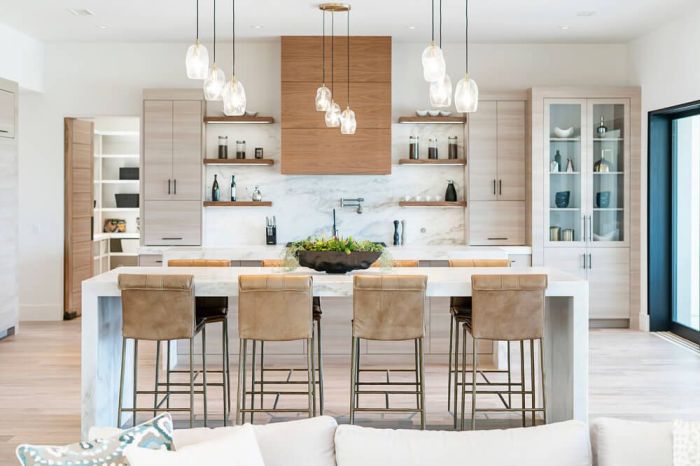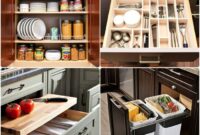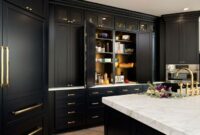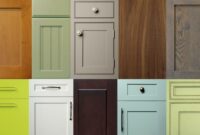High-End Cabinetry Solutions transform kitchens from functional spaces into stunning focal points. We delve into the world of exquisite materials, meticulous craftsmanship, and personalized design, exploring how these elements combine to create cabinetry that elevates any home. From selecting the perfect wood species and finish to integrating smart technology, we’ll guide you through the process of choosing and installing high-end cabinets that reflect your unique style and enhance your lifestyle.
This exploration covers everything from understanding the defining characteristics of high-end cabinetry to navigating the design considerations, material choices, and customization options available. We’ll also address the cost implications and long-term value proposition, ensuring you have the information needed to make informed decisions about this significant investment.
Defining High-End Cabinetry
High-end cabinetry represents a significant investment, offering superior quality, craftsmanship, and design compared to standard options. The difference lies not just in the materials used, but also in the meticulous attention to detail throughout the entire manufacturing process, resulting in pieces that are both functional and aesthetically stunning. These cabinets are built to last a lifetime, enhancing the value and beauty of any home.
Several key characteristics distinguish high-end cabinetry from mass-produced alternatives. These include the selection of premium materials, superior joinery techniques, intricate design details, and customizability to meet individual needs and preferences. The overall result is a level of quality and sophistication that is readily apparent.
High-End Cabinet Materials and Their Properties
The choice of materials significantly impacts the durability, aesthetics, and cost of high-end cabinetry. Different materials offer unique properties, allowing for a wide range of design possibilities to suit diverse tastes and styles.
| Material | Property | Cost Impact | Aesthetic Appeal |
|---|---|---|---|
| Solid Wood (e.g., Cherry, Walnut, Mahogany) | Durable, rich grain patterns, can be stained or finished in various ways | High | Classic, luxurious, warm |
| Veneer (e.g., Maple, Oak) | Cost-effective alternative to solid wood, offers similar aesthetic appeal with thinner layers of wood | Medium | Elegant, versatile |
| High-Pressure Laminate (HPL) | Extremely durable, resistant to scratches, stains, and moisture | Medium-Low | Modern, clean lines, wide range of colors and patterns |
| Metal (e.g., Stainless Steel, Aluminum) | Modern, durable, resistant to heat and moisture | Medium-High | Sleek, contemporary, industrial |
| Hardware (e.g., Solid Brass, Crystal Knobs) | Adds to overall aesthetic and functionality; durability varies with material | Varies greatly | Enhances the overall design; contributes significantly to the overall look and feel |
Manufacturing Processes of High-End Cabinetry
High-end cabinetry manufacturing differs significantly from mass production. Instead of automated processes and pre-fabricated components, skilled craftsmen employ time-honored techniques, paying close attention to detail at each stage. This includes careful wood selection, precise joinery (like dovetail joints), meticulous finishing, and the use of high-quality hardware. Custom designs are often incorporated, allowing for unique solutions tailored to specific spaces and client preferences.
The entire process is far more labor-intensive, resulting in a superior, bespoke product. In contrast, mass-produced cabinets often utilize cheaper materials, simpler joinery methods, and less refined finishing, leading to a shorter lifespan and less aesthetic appeal.
Design Considerations for High-End Kitchens: High-End Cabinetry Solutions
Designing a high-end kitchen requires careful consideration of various factors to ensure both functionality and aesthetic excellence. The ultimate goal is to create a space that is not only beautiful but also highly efficient and enjoyable to use. This involves thoughtful planning of the layout, selection of appropriate cabinetry styles, and seamless integration of appliances and lighting.
Modern Kitchen Layout Incorporating High-End Cabinetry
A modern kitchen layout emphasizes clean lines, efficient workflow, and ample storage. Imagine a spacious kitchen with an island as the central hub. The island could incorporate a sink and seating for casual dining, creating a social space within the kitchen. High-end cabinetry, perhaps in a sleek, frameless style with integrated handles, would line the perimeter walls. Tall pantry cabinets maximize vertical storage, while base cabinets provide ample space for cookware, appliances, and food storage.
A dedicated coffee station, complete with built-in espresso machine and shelving for mugs, could be integrated into a section of the cabinetry. Countertops made of a durable, high-end material like quartz or marble would complete the design, offering both beauty and practicality. The overall effect would be a sophisticated and functional space that seamlessly blends form and function.
Impact of Different Cabinet Styles on Kitchen Design
The choice of cabinet style significantly influences the overall aesthetic of a high-end kitchen. Different styles evoke different feelings and suit different design preferences.
- Shaker: Shaker cabinets, characterized by their simple, five-piece door design with a recessed center panel, offer a timeless and classic appeal. They work well in both traditional and transitional kitchens, providing a balance between elegance and practicality.
- Slab: Slab cabinets feature flat, smooth doors without any raised panels or details. This minimalist style creates a sleek, modern look, ideal for contemporary kitchens. They are often paired with handleless designs for a seamless appearance.
- Frameless (European): Frameless cabinets, also known as European-style cabinets, have doors that mount directly to the cabinet box. This design maximizes interior space and creates a clean, contemporary look. They are often chosen for their modern aesthetic and efficient use of space.
Integration of Appliances and Lighting within High-End Cabinetry
Seamless integration of appliances and lighting is crucial for a cohesive and sophisticated high-end kitchen design. Appliances can be fully integrated into the cabinetry, creating a clean and uncluttered look. This includes dishwashers, ovens, refrigerators, and even microwaves, all hidden behind custom panels that match the cabinetry. Recessed lighting within the cabinetry can provide task lighting for food preparation areas, while under-cabinet lighting illuminates countertops and enhances the overall ambiance.
Pendant lights above the island or peninsula can serve as both functional and decorative elements, adding a touch of elegance to the space. The careful placement and type of lighting, integrated thoughtfully into the design, dramatically impact the kitchen’s overall mood and functionality.
Materials and Finishes in High-End Cabinetry
Choosing the right materials and finishes is crucial in creating truly high-end cabinetry. The selection process impacts not only the aesthetic appeal but also the longevity, maintenance needs, and overall cost of your kitchen. Understanding the properties of different materials and finishes is key to making informed decisions that align with your budget and design vision.
The durability, maintenance, and cost of various high-end cabinet materials significantly influence the overall project. Let’s examine some popular choices.
Comparison of High-End Cabinet Materials
The following comparison highlights the key differences between popular high-end cabinet materials, focusing on durability, maintenance, and cost.
- Solid Wood: Offers exceptional durability and a timeless, luxurious look. It’s easily refinished, allowing for updates over time. However, solid wood is the most expensive option and requires regular maintenance, including occasional refinishing to prevent damage from moisture and wear. Expect a higher initial investment, but it’s a material that can last generations with proper care.
- Veneer: A more affordable alternative to solid wood, veneer consists of a thin layer of real wood glued onto a substrate (typically plywood or MDF). It provides a similar aesthetic appeal to solid wood, but it’s less durable and cannot be refinished as easily. Maintenance is relatively low, but damage to the veneer layer can be difficult to repair.
Veneer represents a good balance between cost and appearance.
- Thermofoil: A cost-effective and low-maintenance option, thermofoil cabinets are made from MDF or particleboard with a vinyl covering. They are highly resistant to moisture and scratches, making them a practical choice for busy kitchens. However, thermofoil lacks the natural beauty and warmth of wood, and damage to the vinyl surface is often irreparable. This is a great option for those prioritizing practicality and budget-friendliness.
Examples of Unique and Sophisticated Finishes
High-end cabinetry often features finishes that go beyond standard options, adding a touch of elegance and personality to the kitchen.
- Custom Paint Colors: Working with a professional painter or cabinetmaker allows for the creation of unique paint colors that perfectly complement the kitchen’s overall design. A subtle, custom shade can create a sophisticated and refined look. Imagine a soft, custom-mixed gray that perfectly complements the natural stone countertops and stainless steel appliances.
- Specialized Stains: Beyond standard wood stains, high-end cabinetry may utilize specialized stains to achieve specific effects. A hand-rubbed stain, for example, can bring out the natural grain of the wood, creating a warm and inviting atmosphere. Consider a dark, hand-rubbed walnut stain that enhances the wood’s natural beauty and creates a dramatic contrast against lighter countertops.
- Metallic Accents: Incorporating metallic accents, such as brushed nickel or antique brass, can add a touch of luxury and visual interest. These accents can be applied to hardware, decorative inlays, or even as part of the cabinet’s finish itself. Imagine a sleek, modern kitchen with cabinets featuring subtle brushed gold leaf detailing, adding a touch of opulence.
Hardware Selection for High-End Cabinetry
Hardware selection is a critical aspect of high-end cabinetry. The right knobs and pulls can elevate the overall design and create a cohesive look.
Hardware should complement the cabinetry’s style and the overall kitchen design. For example, sleek, modern bar pulls might be ideal for a contemporary kitchen with minimalist aesthetics, while ornate knobs might suit a traditional kitchen. Consider the scale of the hardware relative to the cabinet size and the overall proportions of the kitchen. High-quality hardware, made from durable materials like solid brass or stainless steel, will enhance the longevity and elegance of the cabinetry.
The finish of the hardware should also complement the cabinet finish – a brushed nickel pull might look stunning against a painted white cabinet, while an antique brass knob might enhance the richness of a dark wood stain. The weight and feel of the hardware should also be considered; quality hardware offers a satisfying tactile experience.
Customization and Personalization Options

Source: planner5d.com
Creating truly high-end cabinetry goes beyond selecting beautiful materials; it’s about crafting pieces that perfectly reflect the homeowner’s lifestyle and aesthetic preferences. This level of personalization ensures the cabinetry isn’t just functional, but a seamless extension of the home’s personality. The design process is a collaborative journey, involving close communication between the client and the cabinetry professional.The process begins with a thorough consultation to understand the client’s needs, from storage requirements and desired functionalities to their preferred design style and color palettes.
Detailed measurements of the space are taken, and the client’s vision is translated into detailed design plans, often incorporating 3D renderings to visualize the final product. This iterative process allows for adjustments and refinements until the design perfectly matches the client’s expectations. Several revisions are common, ensuring complete satisfaction before production begins. Throughout the process, samples of materials and finishes are presented, allowing for hands-on evaluation and selection.
Innovative Design Features and Customization Options
High-end cabinetry offers a wide array of customization options far beyond standard offerings. These options enhance both functionality and aesthetics, transforming the kitchen into a truly personalized space. The following table highlights some key features and their associated costs:
| Feature | Description | Benefits | Cost Considerations |
|---|---|---|---|
| Built-in Organizers | Custom-designed drawers, dividers, and pull-outs for optimal organization of pots, pans, utensils, and other kitchen items. May include specialized racks for spices, cutlery trays, and pull-out pantries. | Improved efficiency, easy access to items, and a more organized and visually appealing kitchen. | Costs vary greatly depending on complexity and materials; expect a premium over standard cabinetry. |
| Specialized Storage Solutions | Tailored solutions for specific needs, such as a dedicated wine rack, a built-in coffee station, or a pull-out spice rack. | Enhanced functionality and convenience, creating a space that caters to individual habits and preferences. | Costs depend on the intricacy of the design and materials; specialized features generally increase the overall cost. |
| Unique Door Styles | Beyond standard slab or shaker styles, options include raised panel doors, glass-front cabinets, custom-shaped doors, and unique hardware selections. | Enhanced aesthetic appeal, personalized style, and a distinctive look that sets the cabinetry apart. | Unique door styles may increase costs depending on the complexity of the design and the materials used. Custom hardware also adds to the expense. |
| Custom Cabinetry Finishes | Beyond standard paint colors and stains, high-end options include specialized finishes like lacquer, high-gloss epoxy, and hand-rubbed techniques. | Creates a unique look, adds durability, and elevates the overall aesthetic of the cabinetry. | Specialized finishes significantly increase the cost due to the time and skill involved in their application. |
Integrating Technology into High-End Cabinetry
The integration of technology is a key aspect of modern high-end cabinetry design. Smart features and hidden charging stations seamlessly blend functionality with aesthetics, creating a kitchen that is both stylish and technologically advanced. For example, a custom island might incorporate hidden wireless charging pads for phones and tablets, eliminating unsightly cords and keeping surfaces clean. Cabinet interiors could be equipped with smart lighting systems, automatically illuminating the space when a door is opened.
Integrated speakers can add a touch of ambiance, while hidden control panels can manage lighting and other smart home devices. These technological advancements enhance convenience and create a more streamlined and efficient kitchen environment. The cost of integrating technology varies widely depending on the complexity and features chosen.
Cost and Value Proposition of High-End Cabinetry
Investing in high-end cabinetry is a significant financial commitment, but understanding the factors influencing cost and the long-term value proposition can help justify the expense. This section breaks down the cost drivers and explores how high-end cabinetry offers a superior return on investment compared to less expensive alternatives.
Several key factors contribute to the higher price tag of high-end cabinetry. Firstly, the materials used are often superior in quality and sourced from sustainable or ethically responsible suppliers. Think exotic hardwoods like cherry or walnut, premium veneers, and durable, high-quality hardware. Secondly, the craftsmanship involved is exceptional; experienced cabinetmakers employ intricate joinery techniques and meticulous finishing processes, demanding more time and specialized skills.
Finally, the design complexity itself can significantly impact cost. Intricate layouts, custom features, and complex finishes all add to the overall expense. Bespoke designs, incorporating unique elements tailored to the homeowner’s specifications, naturally command a higher price.
Factors Influencing Cost, High-End Cabinetry Solutions
The cost of high-end cabinetry is a multifaceted equation. It’s not simply the sum of materials; the labor involved, the complexity of the design, and the level of customization all play crucial roles. For instance, hand-painted finishes require significantly more time and skill than standard factory-applied finishes, leading to a higher cost. Similarly, complex millwork, such as elaborate crown molding or intricate carvings, increases both material and labor costs.
Long-Term Value and Return on Investment
While the initial investment in high-end cabinetry is substantial, the long-term benefits significantly outweigh the upfront cost. The superior quality and craftsmanship translate into increased durability and longevity, ultimately saving money in the long run by avoiding frequent replacements or repairs. Moreover, high-end cabinetry significantly enhances the aesthetic appeal of a home, boosting its resale value.
- Durability and Longevity: High-quality materials and construction techniques ensure the cabinetry will withstand the test of time, lasting for decades with minimal maintenance.
- Resale Value Enhancement: High-end kitchens are a significant selling point for homes, commanding higher prices and attracting more discerning buyers.
- Aesthetic Enhancement: The superior design and craftsmanship of high-end cabinetry elevate the overall look and feel of a kitchen, creating a luxurious and inviting space.
Lifecycle Cost Comparison
A direct comparison of lifecycle costs helps illustrate the value proposition of high-end cabinetry. While the initial investment is higher, the long-term costs are significantly lower due to increased durability and longevity.
| Feature | High-End Cabinetry | Mid-Range Cabinetry | Low-End Cabinetry |
|---|---|---|---|
| Initial Cost | $30,000 – $60,000+ | $10,000 – $20,000 | $5,000 – $10,000 |
| Lifespan (Years) | 30+ | 15-20 | 5-10 |
| Annualized Cost | $1,000 – $2,000 | $500 – $1,333 | $500 – $2,000 |
| Repair/Replacement Costs | Low | Moderate | High |
Note: These figures are estimates and can vary significantly based on specific project details, location, and materials used. The annualized cost is calculated by dividing the initial cost by the lifespan. The repair/replacement costs reflect the likelihood of needing repairs or replacements over the lifespan of the cabinetry.
Final Wrap-Up
Ultimately, investing in high-end cabinetry is an investment in quality, style, and lasting value. By carefully considering design, materials, and customization options, you can create a kitchen that is both beautiful and functional, a space that reflects your personal style and enhances your daily life for years to come. The attention to detail, superior craftsmanship, and enduring materials ensure that your high-end cabinetry will not only enhance your home’s aesthetic appeal but also provide a significant return on your investment.
Questions and Answers
What’s the average lifespan of high-end cabinets?
With proper care, high-end cabinets can last 50 years or more.
Can I finance high-end cabinetry?
Many cabinet retailers offer financing options; check with your chosen supplier.
How much does installation typically cost?
Installation costs vary greatly depending on the complexity of the project and your location. Get multiple quotes.
What about warranty and maintenance?
High-end manufacturers typically offer warranties; regular cleaning and occasional touch-ups are key for maintenance.
Are there eco-friendly options in high-end cabinetry?
Yes, many manufacturers use sustainably sourced wood and eco-friendly finishes.



